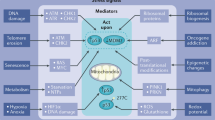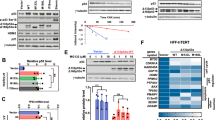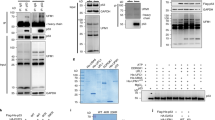Abstract
The tumour-suppressor p53 is a short-lived protein that is maintained at low, often undetectable, levels in normal cells. Stabilization of the protein in response to an activating signal, such as DNA damage, results in a rapid rise in p53 levels and subsequent inhibition of cell growth1. Tight regulation of p53 function is critical for normal cell growth and development, and one mechanism by which p53 function is controlled is through interaction with the Mdm2 protein2–4. Mdm2 inhibits p53 cell-cycle arrest and apoptic functions5,6 and we show here that interaction with Mdm2 can also result in a large reduction in p53 protein levels through enhanced proteasome-dependent degradation. Endogenous levels of Mdm2 are sufficient to regulate p53 stability, and overexpres-sion of Mdm2 can reduce the amount of endogenous p53. Because mdm2 is transcriptionally activated by p53 (refs 7, 8), this degradative pathway may contribute to the maintenance of low p53 concentrations in normal cells. Furthermore, mechanisms regulating the Mdm2-induced degradation of p53 may play a role in controlling the extent and duration of the p53 response.
This is a preview of subscription content, access via your institution
Access options
Subscribe to this journal
Receive 51 print issues and online access
$199.00 per year
only $3.90 per issue
Buy this article
- Purchase on SpringerLink
- Instant access to full article PDF
Prices may be subject to local taxes which are calculated during checkout
Similar content being viewed by others
References
Bates, S. & Vousden, K. H. p53 in signalling checkpoint arrest or apoptosis. Current Opin. Genet. Dev. 6, 1–7 (1996).
Barak, Y. & Oren, M. Enhanced binding of a 95 kDa protein to p53 in cells undergoing p53-mediated growth arrest. EMBO J. 11, 2115–2121 (1992).
Momand, J., Zambetti, G. P., George, D. L. & Levine, A. J. The mdm-2 oncogene product forms a complex with the p53 protein and inhibits p53-mediated transactivation. Cell 69, 1237–1245 (1992).
Chen, J. D., Marechal, V. & Levine, A. J. Mapping of the p53 and mdm-2 interaction domains. Mol. Cell. Biol. 13, 4107–4114 (1993).
Haupt, Y., Barak, Y. & Oren, M. Cell type-specific inhibition of p53-mediated apoptosis by mdm2. EMBO J. 15, 1596–1606 (1996).
Chen, J., Wu, X., Lin, J. & Levine, A. J. mdm-2 inhibits the Gl arrest and apoptosis functions of the p53 tumor suppressor protein. Mol. Cell. Biol. 16, 2445–2452 (1996).
Barak, Y., Juven, T., Haffner, R. & Oren, M. mdm-2 expression is induced by wild type p53 activity. EMBO J. 12,461–468 (1993).
Wu, X. W., Bayle, J. H., Olson, D. & Levine, A. J. The p53 mdm-2 autoregulatory feedback loop. Genes Dev. 7, 1126–1132(1993).
Montes de Oca Luna, R., Wagner, D. S. & Lozano, G. Rescue of early embryonic lethality in mdm2-deficient mice by absence of p53. Nature 378, 203–206 (1995).
Jones, S. N., Roe, A. E., Donehower, L. A. & Bradley, A. Rescue of embyonic lethality in Mdm2-deficient mice by absence of p53. Nature 378, 206–208 (1995).
Xiao, Z.-X. et al. Interaction between the retinoblasmoma protein and the oncoprotein MDM2. Nature 375, 694–697 (1995).
Martin, K. et al. Stimulation of E2F1/DP1 transcriptional activity by MDM2 oncoprotein. Nature 375, 691–694 (1995).
Marston, N. J., Crook, T. & Vousden, K. H. Interaction of p53 with MDM2 is independent of E6 and does not mediate wild type transformation suppressor function. Oncogene 9, 2707–2716 (1994).
Lin, J., Chen, J., Elenbaas, B. & Levine, A. J. Several hydrophobic amino acids in the p53 amino-terminal domain are required for transcriptional activation, binding to mdm-2 and the adenovirus 5 E1B 55-kD protein. Genes Dev. 8, 1235–1246 (1994).
Lees-Miller, S. P., Sakaguchi, K., Ullrich, S. J., Appella, E. & Anderson, C. W. Human DNA-activated protein kinase phosphorylates serines 15 and 37 in the amino-terminal transactivation domain of human p53. Mol. Cell. Biol. 12, 5041–5049 (1992).
Scheffner, M., Werness, B. A., Huibregtse, J. M., Levine, A. J. & Howley, P. M. The E6 oncoprotein encoded by human papillomavirus types 16 and 18 promotes the degradation of p53. Cell 63, 1129–1136 (1990).
Hubbert, N. L., Sedman, S. A. & Schiller, J. T. Human papillomavirus type 16 E6 increases the degradatin rate of p53 in human keratinocytes. J. Virol. 66, 6237–6241 (1992).
Jones, S. N. et al. The tumorigenic potential and cell growth characteristics of p53-deficient cells are equivalent in the presence or absence of Mdm2. Proc. Natl Acad. Sci. USA 93, 14106–14111 (1996).
Wrede, D., Tidy, J. A., Crook, T., Lane, D. & Vousden, K. H. Expression of RB and p53 proteins in HPV-positive and HPV-negative cervical carcinoma cell lines. Mol. Carcinog. 4, 171–175 (1991).
Maki, C. G., Huibregtse, J. & Howley, P. M. In vivo ubiquitination and proteosome-mediated degradation of p53. Cancer Res. 56, 2649–2654 (1996).
Kubbutat, M. H. G. & Vousden, K. H. Proteolytic cleavage of human p53 by calpain: a potential regulator of protein stability. Mol. Cell Biol 17, 460–468 (1997).
Fenteany, G. et al. Inhibition of proteasome activities and subunit-specific amino-terminal threonine modification by lactacytin. Science 268, 726–731 (1995).
Oliner, J. D. et al. Oncoprotein MDM2 conceals the activation domain of tumour suppressor p53. Nature 362, 857–860 (1993).
Haupt, Y., Maya, R., Kazaz, A. & Oren, M. Mdm2 promotes the rapid degradation of p53. Nature 387, 296–299 (1997).
Di Leonardo, A., Linke, S. P., Clarkin, K. & Wahl, G. M. DNA damage triggers a prolonged p53-dependent Gl arrest and long-term induction of Cipl in normal human fibroblasts. Genes Dev. 8, 2540–2551 (1994).
Perry, M. E., Piette, J., Zawadzki, J. A., Harvey, D. & Levine, A. J. The mdm-2 gene is induced in response to UV light in a p53-dependent manner. Proc. Natl Acad. Sci. USA 90, 11623–11627 (1993).
Chen, C. Y. et al. Interactions between p53 and MDM2 in a mammalian cell cycle checkpoint pathway. Proc. Natl Acad. Sci. USA 91, 2684–2688 (1994).
Marston, N. J. Mutational Analysis of the Tumour Suppressor Protein p53. Thesis, Univ. London (1996).
Marston, N. J., Jenkins, J. R. & Vousden, K. H. Oligomerisation of full length p53 contributes to the interaction with mdm2 but not HPV E6. Oncogene 10, 1707–1715 (1995).
Rowan, S. et al. Specific loss of apoptotic but not cell cycle arrest function in a human tumour derived p53 mutant. EMBO J. 15, 827–838 (1996).
Author information
Authors and Affiliations
Rights and permissions
About this article
Cite this article
Kubbutat, M., Jones, S. & Vousden, K. Regulation of p53 stability by Mdm2. Nature 387, 299–303 (1997). https://doi.org/10.1038/387299a0
Received:
Accepted:
Issue Date:
DOI: https://doi.org/10.1038/387299a0
This article is cited by
-
Elevated expression of WSB2 degrades p53 and activates the IGFBP3-AKT-mTOR-dependent pathway to drive hepatocellular carcinoma
Experimental & Molecular Medicine (2024)
-
Pharmacological reactivation of p53 in the era of precision anticancer medicine
Nature Reviews Clinical Oncology (2024)
-
YTHDC1 m6A-dependent and m6A-independent functions converge to preserve the DNA damage response
The EMBO Journal (2024)
-
Effect of adjuvant chemotherapy on localized dedifferentiated low-grade osteosarcoma: a systematic review
MUSCULOSKELETAL SURGERY (2024)
-
ARTS and small-molecule ARTS mimetics upregulate p53 levels by promoting the degradation of XIAP
Apoptosis (2024)



